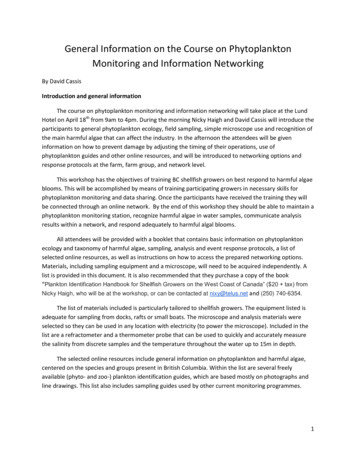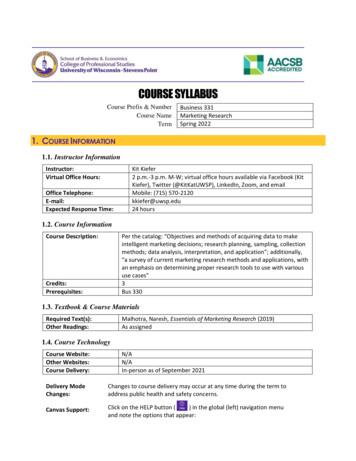
Transcription
General Information on the Course on PhytoplanktonMonitoring and Information NetworkingBy David CassisIntroduction and general informationThe course on phytoplankton monitoring and information networking will take place at the LundHotel on April 18th from 9am to 4pm. During the morning Nicky Haigh and David Cassis will introduce theparticipants to general phytoplankton ecology, field sampling, simple microscope use and recognition ofthe main harmful algae that can affect the industry. In the afternoon the attendees will be giveninformation on how to prevent damage by adjusting the timing of their operations, use ofphytoplankton guides and other online resources, and will be introduced to networking options andresponse protocols at the farm, farm group, and network level.This workshop has the objectives of training BC shellfish growers on best respond to harmful algaeblooms. This will be accomplished by means of training participating growers in necessary skills forphytoplankton monitoring and data sharing. Once the participants have received the training they willbe connected through an online network. By the end of this workshop they should be able to maintain aphytoplankton monitoring station, recognize harmful algae in water samples, communicate analysisresults within a network, and respond adequately to harmful algal blooms.All attendees will be provided with a booklet that contains basic information on phytoplanktonecology and taxonomy of harmful algae, sampling, analysis and event response protocols, a list ofselected online resources, as well as instructions on how to access the prepared networking options.Materials, including sampling equipment and a microscope, will need to be acquired independently. Alist is provided in this document. It is also recommended that they purchase a copy of the book“Plankton Identification Handbook for Shellfish Growers on the West Coast of Canada” ( 20 tax) fromNicky Haigh, who will be at the workshop, or can be contacted at nixy@telus.net and (250) 740-6354.The list of materials included is particularly tailored to shellfish growers. The equipment listed isadequate for sampling from docks, rafts or small boats. The microscope and analysis materials wereselected so they can be used in any location with electricity (to power the microscope). Included in thelist are a refractometer and a thermometer probe that can be used to quickly and accurately measurethe salinity from discrete samples and the temperature throughout the water up to 15m in depth.The selected online resources include general information on phytoplankton and harmful algae,centered on the species and groups present in British Columbia. Within the list are several freelyavailable (phyto- and zoo-) plankton identification guides, which are based mostly on photographs andline drawings. This list also includes sampling guides used by other current monitoring programmes.1
Schedule9 - 9:30AM BCSGA AGM9:30-10:15 Introduction to ecology of plankton and plankton sampling10:15 - 10:30 coffee break10:30 - 11AM Plankton sampling demonstration11AM - 12:00PM Introduction to microscopes and sample analysis12:00 - 1PM lunch1PM - 2PM Harmful algae species - talk and microscope2PM - 2:30PM Using plankton monitoring for shellfish site husbandry2:30-3:30 PM Networking and online resources3:30 - 4PM sum-up and discussion2
VenueTime: 9am to 4pmLocation: Lund Hotel; 1436 101 Highway, Lund, BC V0N 2G0(604) 414-0474Map and information http://lundhotel.com/site/location - map.html3
Recommended MaterialsMaterialsMicroscopePlankton netSedgewick-rafter counting cellLugol iodine solutionSlidesCoverslipsPipettesAmber sample bottlesGuideQuantity1111/2 liter1 box1 box1 box1 box (of 1 dozen)1SupplierAmscopeDynamic AquaDynamic AquaDynamic AquaDynamic AquaDynamic AquaDynamic AquaDynamic AquaNicky HaighModelB490BMPN 2015084C10603501000604000E55021Total without optionalequipmentPrice per unit300*11546375,95583520571,95OptionalThermometer probe1Dynamic AquaClinefinder175Refractometer (salinity)1Dynamic AquaSTX 3115* Several options exist for microscopes ranging in price from around 270 upwards. Please contactDavid Cassis davidcassis@gmail.com if you need more information.Links to suppliers:Amscope http://store.amscope.com/b490b-m.htmlDynamic Aqua w.dynamicaqua.com/refractometers.htmlSelected online resources Phyto’pedia, the visual encyclopedia of common plankton in BC. A new resource that compilesecological and taxonomic information with high quality images in accessible language. Centeredon phytoplankton and counts with seasonal n/4
Cupp’s Marine plankton diatoms of the west coast of North America. A thorough guide of thediatoms of the west coast made mostly with clear line drawings. An excellent resource despite afew outdated names. omsA list of species common in the west coast with nice images prepared by the Kudela Lab at theUniversity of California Santa Cruz http://oceandatacenter.ucsc.edu/PhytoGallery/A guide of common species with annotated images prepared by the Global Ballast WaterManagement 0phytoplankton%20catalogue.pdfGood general guide for the plankton prepared by Robert Perry - UCLA OceanGLOBE & MalibuHigh School http://www.msc.ucla.edu/oceanglobe/pdf/guide plankton1.pdfA general explanation about phytoplankton and harmful algae blooms with images prepared byGregg W. Langlois and Patricia Smith http://pubs.usgs.gov/circ/c1198/chapters/123132 Phytoplankton.pdf This is a chapter of the book Beyond the Golden Gate—Oceanography,Geology, Biology, and Environmental Issues in the Gulf of the Farallones. Edited by Herman A.Karl, John L. Chin, Edward Ueber, Peter H. Stauffer, and James W. Hendley II. 2001. This is a bookon oceanography and marine biology that can be downloaded for free herehttp://pubs.usgs.gov/circ/c1198/NOAA’s harmful algal bloom hunter’s handbook. A complete guide with activities, generalinformation, photo ch/pdf files/habhunthdbk.pdfHarmful Plankton Project, a user-friendly guide to harmful phytoplankton in EU waters createdby A Kraberg and DJS Montagnes http://www.liv.ac.uk/hab/intro.htm A complete guide toharmful algae with ecological and taxonomic information as well as images.Simple key for common zooplankton prepared by the University of Georgia Marine EducationCenter and oads/media/Zooplankton key.pdfAn easy to use image-based zooplankton key of prepared by the University of New Hampshire,Durham http://cfb.unh.edu/cfbkey/html/index.htmlOverview of the plankton in the Pacific north coast integrated management area mapublications/pncima eoar 328842 d plankton.pdfDavid CassisAquaBC ConsultingPh:1-778 882 6576davidcassis@gmail.com5
phytoplankton monitoring and data sharing. Once the participants have received the training they will be connected through an online network. By the end of this workshop they should be able to maintain a phytoplankton monitoring station, recognize harmful algae in water samples, communicate analysis











